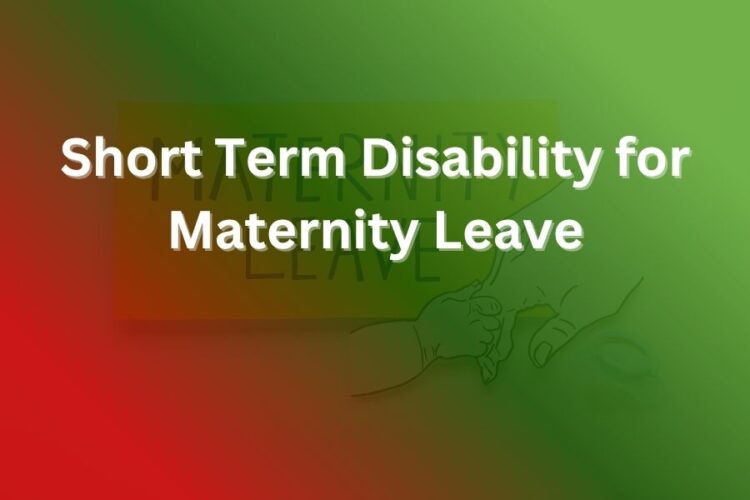When you’re planning for maternity leave, understanding how short-term disability (STD) insurance works can make a big difference. Many new parents are surprised to learn that STD can replace a portion of your income while you’re physically unable to work due to pregnancy or childbirth.
Short-term disability is not the same as paid family leave. Instead, it covers the time when your doctor certifies that you are medically unable to perform your job because of childbirth or recovery.
Why Understanding Short-Term Disability for Maternity Leave Matters
Many people assume maternity leave automatically includes pay, but that’s rarely true. In most cases, maternity leave simply guarantees your job will be held while you’re away. The actual income replacement often depends on whether you have STD coverage.
Only a fraction of U.S. workers have paid family leave, and even fewer understand how STD works for pregnancy. Knowing your options can save you from unnecessary financial stress.
Short-term disability insurance provides income replacement when pregnancy complications, childbirth, or recovery prevent you from working. The money you receive can help cover bills, childcare, and everyday expenses while you focus on healing and bonding with your baby.
How Short-Term Disability Works During Maternity Leave
Coverage Period
STD benefits typically start before or right after childbirth and last through your medical recovery. In most cases:
Vaginal delivery qualifies for about six weeks of disability benefits.
Cesarean (C-section) delivery can extend that to about eight weeks or more.
If complications arise or your doctor orders bed rest, benefits may last longer.
Benefit Amount
Most STD policies replace 40% to 70% of your regular income. The exact percentage depends on your employer’s plan or your personal policy. Some plans even allow you to use vacation or sick days to make up the remaining difference.
Elimination Period
Before STD payments begin, there’s often a waiting period known as the elimination period. This could range from a few days to a couple of weeks. During that time, you may need to use sick leave or vacation pay to fill the gap.
Key Eligibility and Policy Details to Review
Before relying on short-term disability for maternity leave, you should carefully review your plan.
Enrollment timing: Many policies require enrollment before pregnancy begins. If you wait until after conception, the pregnancy might be considered a pre-existing condition.
Covered conditions: Make sure both normal childbirth and C-sections are included, along with potential complications such as bed rest or postpartum issues.
Length and benefit rate: Check how many weeks are covered and what percentage of your income is replaced.
Coordination with other leave types: STD usually runs separately from paid family leave or job-protected unpaid leave like FMLA.
State laws: Some states, such as California, New York, and New Jersey, have mandatory disability programs that work alongside or in place of employer STD plans.
Short-Term Disability vs. Paid Family Leave vs. FMLA
It’s easy to confuse these programs, but they serve different purposes.
Short-Term Disability: Replaces part of your income during the period when you’re physically unable to work due to pregnancy or childbirth.
Paid Family Leave (PFL): Provides partial income while you bond with your baby, care for a family member, or handle other qualifying events.
Family and Medical Leave Act (FMLA): A federal law that guarantees up to 12 weeks of job-protected but unpaid leave for childbirth, adoption, or serious illness.
Typically, STD covers the medical recovery phase (six to eight weeks), while PFL or unpaid FMLA can extend your bonding time once you’re medically cleared to return to work.
How to Prepare for Maternity Leave with Short-Term Disability
Review your benefit materials: Read your employee handbook or insurance documents carefully. Note how long benefits last, the elimination period, the coverage percentage, and any exclusions.
Confirm eligibility and timing: Make sure you’ve met any pre-enrollment or waiting period requirements. Some plans require active coverage months before childbirth.
Coordinate your leave plan: Combine STD benefits with paid vacation, sick leave, or state-specific programs to maximize your income and time off.
Contact HR and your insurer: Ask when to submit paperwork. Some insurance carriers require you to file a claim before your due date to avoid delays.
Plan your finances: STD benefits rarely replace your full paycheck, so plan ahead. Build savings or create a budget to cover the difference.
Keep medical documentation: You’ll need certification from your healthcare provider confirming you’re medically unable to work during pregnancy or postpartum recovery.
Common Mistakes to Avoid
Assuming STD covers your full leave: STD generally applies only to the recovery period, not extended bonding time.
Enrolling too late: Waiting until after pregnancy starts could make you ineligible.
Not coordinating multiple benefits: Overlapping STD and state disability programs can reduce your overall payout if not managed correctly.
Ignoring exclusions: Some plans don’t cover pre-existing conditions or voluntary procedures.
Skipping claim deadlines: Failing to file paperwork on time could result in delayed or denied benefits.
Example Scenario
Imagine you’re expecting a baby in three months and your employer offers STD coverage that pays 60% of your salary for up to eight weeks. After you give birth, you qualify for STD during your six-week recovery.
Once that period ends, you choose to use your state’s paid family leave for an additional six weeks to bond with your newborn. Together, these programs provide income coverage for roughly three months, giving you peace of mind and time to focus on your family.
Final Thoughts
Planning for maternity leave isn’t just about time off — it’s also about protecting your income. Short-term disability insurance is one of the best ways to maintain financial stability while you recover from childbirth.
Before your due date, take the time to review your policy, understand your options, and coordinate STD benefits with any paid or unpaid family leave programs available to you. With the right preparation, you can make your maternity leave a period of healing, joy, and financial security.










